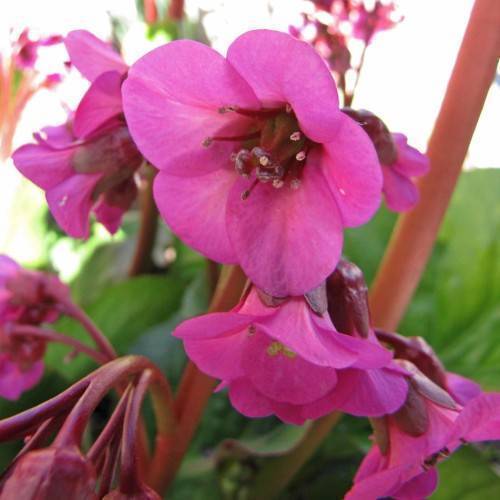
purple bergenia
Bergenia purpurascens
Cycle:
Herbaceous Perennial
Watering:
Average
Hardiness Zone:
4 - 8
Flowers:
Flowers
Sun:
Part shade,full shade
Leaf:
Yes
Growth Rate:
Low
Maintenance:
Low
Drought Tolerant:
Yes
Salt Tolerant:
Yes
Care Level:
Medium
watering
When watering Purple Bergenia, it is important to make sure you are properly watering based on your local climate. In general, during the growing season (spring and summer), water it deeply about once a week or when the top 1-2 inches of soil starts to feel dry. In hot, dry climates, the plant may need to be watered more frequently. During the winter, when Purple Bergina is dormant, allow the soil to dry out completely between waterings. When watering, make sure the soil is evenly moist, but not saturated. Aim for about 1 inch of water per week.
sunlight
Purple bergenia (Bergenia purpurascens) should be situated in a spot that receives morning sun (for approximately 4-5 hours) and then afternoon shade (for the remaining hours). The plant prefers partial shade rather than full sun, so it's important to choose its location carefully to prevent burn damage caused by too much light. Morning sun will help the plant to flower in regular cycles and provide the necessary light needed for healthy, strong growth. During the summer months, when the days are longer, some extra protection during the peak hours of the afternoon can be beneficial. In the winter, when days are shorter, the plant can handle more light without issue.
pruning
Purple Bergenia is a hardy and easy-to-grow perennial native to the Himalaya Mountains. Pruning is an important part of maintaining your Bergenia’s health and beauty. Pruning should be done in early spring before new growth begins and should be repeated on an annual basis. For lighter pruning, remove any dead, damaged, or overly spindly stems and cut back the remaining stems to the point where leaves were present on the stem before. This will encourage new and fuller growth from the base of the plant. For more extensive pruning, cut back the stems to several inches above the ground. This will encourage both more light and air circulation and will produce new stems from the base of the plant. Prune any foliage around the center of the plant to promote better air circulation to the crown and prevent fungal problems. In late fall (November-December), cut the dead and browning flower stems back to the crown of the plant. This will help the plant retain energy during the dormant period and will give it a jump-start into the growing season in spring. Pruning your Purple Bergenia will help to keep the plant healthy and looking its best. With an annual pruning, your Bergenia will be rewarded with lush and beautiful foliage all season long.
